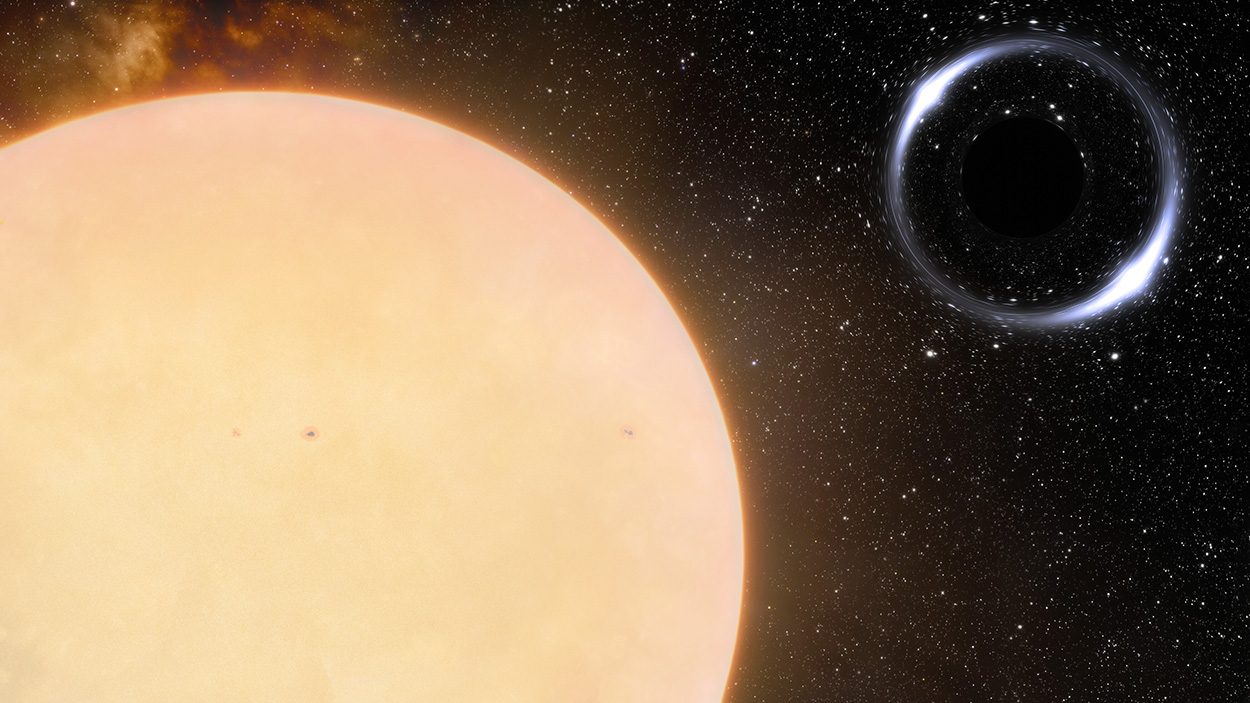Stellar black holes form when a massive star reaches the end of its life cycle and explodes in a supernova. Astronomers have now discovered the closest example of such a black hole to Earth at a distance of 1,560 light-years. It is an inactive and therefore invisible black hole of ten solar masses orbiting a Sun-like star. Minor changes in his movements betrayed the presence of the “silent” partner. However, it is not yet clear how this pair arose, because the distance between the star and the black hole does not fit popular ideas.
There are an estimated hundreds of millions of stellar black holes in our Milky Way. However, astronomers have so far not been able to track down a tiny fraction of them – a few dozen samples. These black holes were mostly part of binary systems and have given up on themselves as they sucked material from their companion star. The gas then orbits around the event horizon as the accretion disk heats up to the point that it emits high-energy X-rays and the entire system becomes visible as an X-ray binary star. Some other stellar black holes have been detected from gravitational waves emitted when they merge with another black hole or with a neutron star.
Look for ‘silent’ black holes
However, inactive stellar black holes are hard to find. Because they do not absorb any substance, no radiation is emitted from their immediate surroundings, and at the same time these holes absorb all the radiation that reaches their attraction. It is true that in recent years there have been several reports of supposed discoveries of dormant black holes. Mostly it was based on anomalies in the orbit or the spectrum of stars accompanying these “dark” partners. But most of these candidates have been put into perspective or even refuted by follow-up studies. Others, such as the inactive black hole in the binary star system V723 Mon, discovered in 2021 only 1,500 light-years away, have yet to be confirmed.
Astronomers led by Karim El-Badri of the Max Planck Institute for Astronomy in Heidelberg and the Harvard-Smithsonian Center for Astrophysics in the US took a slightly different approach. In their search for silent black holes, they evaluated the recently published third dataset from the European space telescope Gaia. This also contains motion and position data for 800,000 fine double star systems in our galaxy. In this data, Al-Badri and his team specifically searched for systems in which a star shows orbital changes typical of a more massive partner, but telescope observations find no visible partners at this point. The team found six candidates whose movements could indicate the presence of a nearby inactive black hole. To verify these candidates, astronomers have also observed six star systems with several ground-based telescopes, including the Gemini North telescope in Hawaii, in order to use changes in radial velocity and light spectra to narrow down the motions and masses of the objects involved.
An invisible partner to a sun-like star
One candidate has withstood all scrutiny: Gaia BH1, a binary system about 1,560 light-years away, made up of a sun-like star and a heavier invisible companion – an inactive black hole. “Our follow-up analyzes with Gemini have unequivocally confirmed that this binary contains an ordinary star and at least one inactive black hole,” the astronomers said. “We were unable to find a plausible astrophysical scenario that could explain the observed orbit of the system without the participation of at least one black hole.” Thus Gaia BH1 is the first clearly visible silent stellar black hole detected in the Milky Way—and at the same time time the stellar black hole closest to us, astronomers explain. “I’ve been looking for a system like the Gaia BH1 for the past four years, and tried all kinds of approaches – but none of them worked. I’m so glad this research finally worked,” says El-Badri.
According to more detailed analyzes, the invisible black hole in Gaia BH1 weighs about ten solar masses, while the sun-like companion star weighs only about one solar mass. Both bodies orbit each other at a distance equal to the distance of the Earth from the Sun. “With an orbital period of 185.6 days, the orbit is farther than any other known stellar black hole binary,” says El-Badri and colleagues. But this is precisely what poses problems for astronomers, because current educational models do not fit into this system. According to calculations, the mass of the black hole’s predecessor star was at least 20 solar masses, and therefore it was short-lived. So it should have swelled up into a super giant and devoured it in the early days of the smaller companion star. If both partners were closer, interactions with the companion star could have prevented this inflation. But that was clearly not the case, as El-Badri and his team explained.
So far, astronomers can only speculate on how this pair of black hole and star originated. So it would be conceivable that the system might have originated in a star cluster. Then, the gravitational perturbation would have moved the smaller companion star, which had previously been orbiting further away, into its orbit. It is also possible that Gaia BH1 is a triple star system with two closely orbiting dense stars. Preventing each other from becoming super giants, then formed two black holes that now orbit so closely that they appear as one. Close examination of this unusual system could determine if this is the case.
Source: Karim El-Badri (Astrophysics Center | Harvard and Smithsonian, Cambridge, USA) et al, Monthly Notices of the Royal Astronomical Society, doi: 10.1093/mnras/stac3140

“Alcohol buff. Troublemaker. Introvert. Student. Social media lover. Web ninja. Bacon fan. Reader.”





More Stories
Huge radiation explosion from a magnetar – forschung.de
Principles and features of the folk nutritional principle
Science: The percentage of women in mint topics rises to a third